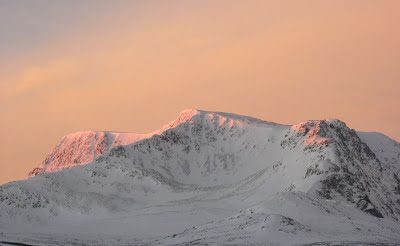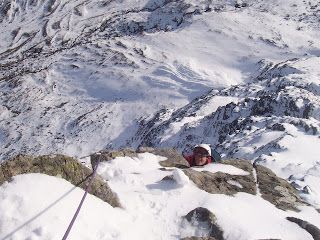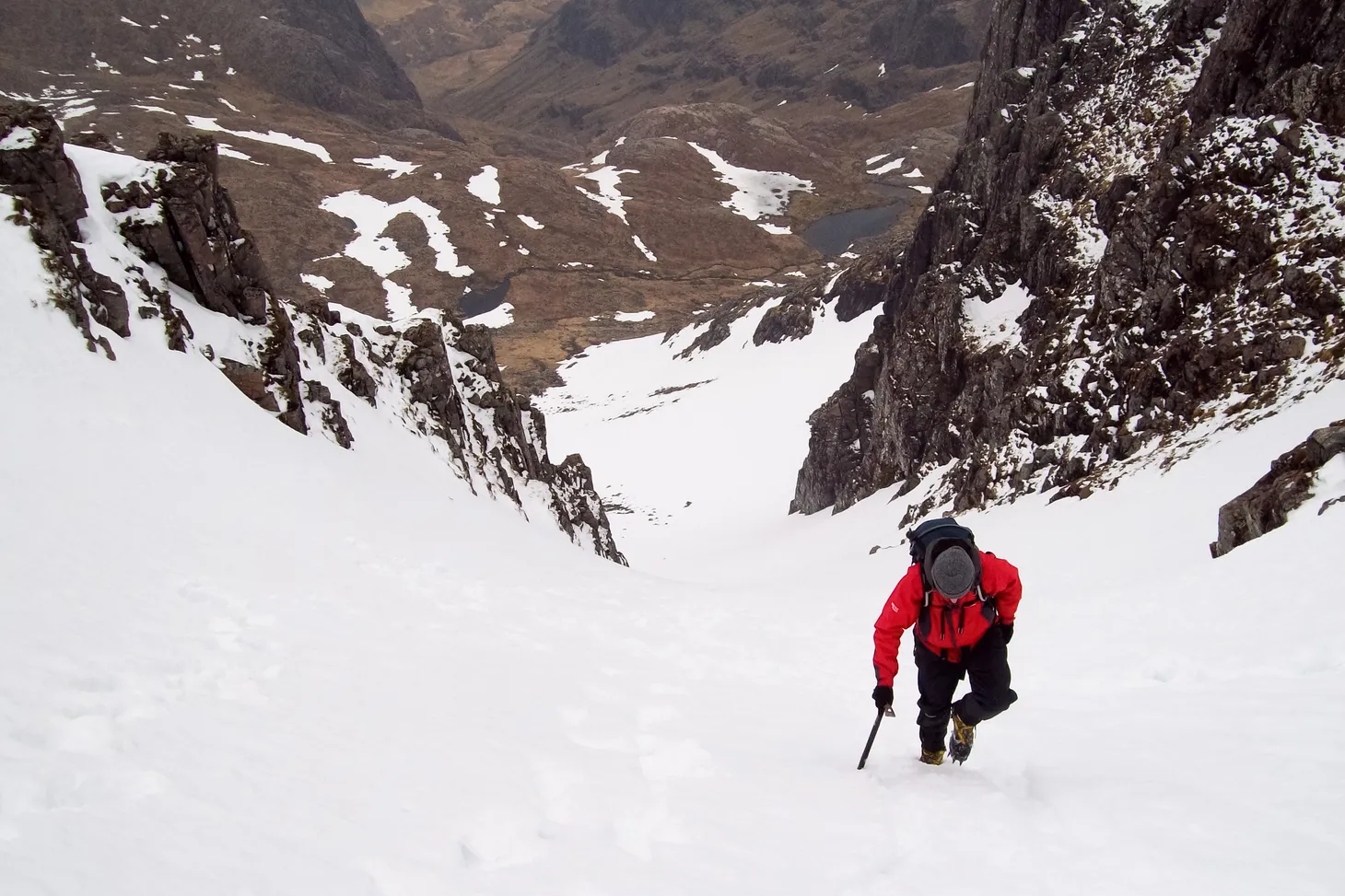Scottish winter climbing: the future
I can think of no finer outdoor playground than the Scottish Highlands. These mountains, only a few hours by car from most of the UK, offer everything the outdoor enthusiast could wish for: spectacular scenery, world-class walking, kayaking and mountain biking, hills of every type from rounded lumps to jagged aretes. Climbers flock from all over the world to test their skills in these mountains. Every month of the year offers its own unique reward, from balmy crag days in May to stonking neve ice in February.
Why is it special?
Alpinism was not invented in the UK, but Scottish winter climbing was. Globally speaking, it’s a subset of the sport of mountaineering and has origins dating back to the 1880s. Why do climbers come from all corners of the planet to scale our mountains in winter?
1. Routes of extraordinary reputation. Certain Scottish routes are of such immense quality and reputation that climbers dream about them for their entire lives. At the lower grades, routes such as Tower Ridge, Point Five Gully and the crossing of the Cuillin are legendary classics. Modern mixed routes are not my area of expertise but many of these have attained similar reputations.
2. Strong traditional ethics. In the Alps, mixed routes tend to be protected by artificial bolts, and there is a generally entrenched practice of equipping easier mountain routes with chains, ropes, ladders, and all manner of unsightly paraphernalia. In Scotland, anything artificial in the mountains is frowned upon thanks to a long upheld tradition of leader-placed protection and ‘ground up’ climbing. That means no bolts, no chains, and certainly no ladders. For a winter route to be considered in condition, it must be white and should not be easier to climb without ice axes and crampons. A sense of fairness is deeply ingrained into Scottish winter climbing–but as we shall see, things are changing.
3. When conditions are good, they’re really good. A maritime climate results in variable conditions, frequently oscillating between deep thaw and blizzards. However, this very unpredictability can occasionally produce what all ice climbers crave: plastic neve ice, a joy to climb on and a totally different experience to cascade climbing elsewhere.
 |
| Ben Alder in February 2012 |
Ethics – past and present
Strong ethics hold the entire game together. For many decades, a code of honour has governed the conduct of climbers in the Scottish hills. As the climbing scene has changed over time, this ethical code has also changed, but at its heart has always been a wish to give the mountain a chance–for climbers to operate with fairness and transparency, making as little impact on the environment as possible.
In the days of the pioneers, climbs of all styles were recorded (snow, pure ice, and mixed/rock). Ethics tended to be largely practical in the 19th century; an ice climb simply couldn’t be done if the ice wasn’t in optimum condition. Attitudes towards mixed climbs were far more relaxed, however. No distinction was made between rock climbing and winter mixed climbing, as the equipment used was exactly the same: nailed boots and long ice axe. As a consequence, the sort of winter mixed routes being done in the period (ridges and buttresses up to Grade IV) did not have to be white in appearance to be considered fair game, and there was little emphasis on the importance of avoiding damage to rock and vegetation. These pioneers usually had to travel great distances to reach their mountains, and had no access to weather forecasts or conditions reports. They had to take the mountain as they found it–or go home.
Victorian ethics focused on simplicity: an unaided man against the challenge of the mountains. Any technology that made climbing easier was frowned upon. They had no ice screws, nuts, or camming devices; twin ice axes hadn’t even been dreamed of (although in my fictional version of events, this development happens rather sooner!)
As the sport matured, new equipment became available, albeit slowly. It took a long time before crampons were adopted as essential gear in the these hills, and well into the 1960s many Scottish mountaineers preferred the old method of nailed boots and cutting steps. A more mature mixed ethic had developed by this time. It was considered unsporting to climb mixed routes in anything but well-frozen, white conditions. Climbers were also starting to become conscious of the environmental impact they were having on the crags.
However, aid climbing became more acceptable in the mid 20th century. If a route was too hard to climb without resting on gear, or using some novel rope trick to cross a barrier, the first ascentionists would not hesitate to use whatever tactics they thought best. However, it was considered vital to declare if any points of aid were used. Many of these routes were climbed ‘free’ by other climbers in future years. A good example of this is Point 5 Gully, which was first climbed siege-style in 1959 and then repeated in a single push by Robin Smith and Jimmy Marshall in 1960.
Ethics became even more important when the modern technique of piolet traction became established at the end of the 1960s. Suddenly mixed routes were being climbed by hooking the picks of axes into cracks: a process that has the potential to cause far more damage to the environment. It’s also easier to ‘dry tool’ routes than to climb them when covered in a decent lathering of snow and ice. To keep the playing field level for everyone, dry tooling–something that was probably widespread in the Victorian era, albeit in a different form–became synonymous with cheating.
Modern mixed ethics became well-established in the 1970s. The message was clear: mixed routes should only be climbed when in undisputable winter condition.
The drytooling controversy
Climbing equipment continues to evolve at a rapid rate. Since the early 1970s there have been several major developments in gear, notable among them the emergence of good quality ice screws, vertical front-points for crampons, monopoint crampons, curved shafts for ice axes, leashless axes, modular picks … the list goes on.
Climbing gear has become increasingly specialised. In the 1980s, a typical winter climber would own a single pair of standard crampons, a ‘walking axe’ (probably 60cm+), and a single pair of ice climbing tools. Nowadays there is a bewildering array of equipment on the market, specialised and fine-tuned to different niches of the sport. Crampons vary from inexpensive models suitable for walking right through to the latest super-light monopoint mixed claws (which are wildly unsuitable for walking in!) Ice axes are even more specialised and most modern climbers will end up owning a number of axes.
To illustrate my point, here is a typical walking axe, the Grivel Air Tech Evolution. It is completely different to Grivel’s current top of the line mixed tool, the Force Carbon.
At the top end, modern gear makes climbing technically challenging terrain easier than ever before. Novices find themselves able to climb feared test-pieces of the 1970s in their first season. It has often been said that there is a general trend away from the traditional Scottish apprenticeship, in which a novice would climb under the guidance of a more experienced climber for years, building up their experience. Those new to the game are climbing harder than ever before
At the same time, the top dogs of the sport are pushing boundaries. Pure ice climbs in Scotland generally max out at Grade VI; the higher grades belong to mixed routes of ever increasing difficulty and steepness. The steepest of these routes feature overhangs which very rarely ice up. In recent years, a number of routes of extreme difficulty have been climbed in conditions which have been described as ambiguous. The online arguments have been vicious, leading some to claim that drytooling is becoming a major problem and that the future of winter climbing is at risk.
A recent ascent by Dave MacLeod has made the issue controversial once again. His route White Goods, a short modern mixed route on Ben Nevis, has been widely criticised as an erosion of traditional Scottish ethics. I have no wish to tarnish Dave’s reputation–he is after all one of the UK’s top climbers–but it is clear that something is changing.
The problem is that conditions can be difficult to judge. What looks white from above might not be white when looked at from below.
For example, a pitch on Castle Ridge:
Was the route in condition? By the standards of the 19th century, absolutely yes. By the standards of the 21st it is slightly more open to interpretation. The mountain was blanketed in snow and ice and the route would have been far more difficult without ice axes and crampons–and yet on the steepest pitches the rock was largely dry. For more of my thoughts about ambiguity when it comes to conditions, see my recent article on The Pinncle Face.
Before the World Wide Web, this ambiguity would not have been a problem. Every climber would do their best to uphold winter ethics, but borderline conditions would not have been viewed and discussed by thousands online.
A pitched battle on UKC has been raging for many days now. Dave MacLeod’s reputation has been dragged through the mud, and all thanks to a single picture posted on his blog. The worry seems to be that where the top climbers of today go, the novices of tomorrow will follow, and dry tooling will become the accepted norm.
We are experiencing an information revolution in our sport and this has highlighted the fact that there are no hard and fast rules for winter climbing. Some would say this is a good thing (and I am inclined to agree), but I believe it will lead to big changes in future.
The inevitable future
Scottish winter climbing already has a vast Web presence. Every instructor keeps a blog, and many casual climbers also blog about their exploits or post on popular forums such as UKClimbing.com. Twitter is teeming with winter mountaineers; the #scotwinter hashtag is a real-time image and conditions feed direct from the crags. Every climber carries a camera and a lot of those photos will end up on Facebook. More than ever before, our activities are under intense scrutiny from our peers and the general media.
Coupled with increasingly high tech equipment, climate change, and a culture that champions the emulation of top climbers by novices, I believe we will see the following developments in future years:
1. Specialist equipment will be used on easier routes. Today’s climbers are already using twin leashless axes on classic low-grade mixed routes like Tower Ridge; thirty years ago that route would have been climbed with a mountaineering axe. This trend will continue (although it isn’t necessarily a bad thing).
2. Digital technology will see widespread use. Ten years ago, virtually nobody used mobile phones in the hills. In 2013 an increasing number of people are relying on smartphone navigation instead of traditional methods, and this trend will only accelerate. It will be used for more than just navigation, too (see point 6).
3. Winter climbing will become increasingly specialised and stratified. Traditional ice climbing and modern mixed will grow even further apart. ‘Winter mountaineering’ (encompassing walking, scrambling and easy routes up to about Grade II) will be left far behind, although I suspect it will become even more influenced by modern mixed climbing.
4. Ethics will change. I think that, for better or for worse, dry tooling will become an established practice. Just as ethics adapted to accommodate crampons, twin ice axes, and ice screws (developments that the Victorians would have considered cheating), in time ethics will also adapt to accommodate dry tooling and future technical developments. Will pre-placed protection, toproping, clipsticks, even bolts become the norm for high-end mixed climbing in the future? It’s certainly a possibility.
5. Turf will vanish from many climbs. Mixed routes relying on frozen turf will become increasingly skeletal as traffic strips away the rare vegetation. Erosion will change the character of many popular routes.
6. The mystery will disappear. As the information age advances, the mystery of winter climbing will recede into the past. Modern climbers already have comprehensive guidebooks, up to date conditions reports, and accurate weather forecasts. Thanks to smartphones, it’s already possible to access this information while actually on the climb. Climbers of the future will have even more information, and as a consequence there will be fewer unknowns. I wouldn’t be surprised if augmented reality starts making an impact on climbing at some point in this decade. It’s already widely used elsewhere.
7. Average grades will rise. In the 1960s, top-end climbers operated at Grade V. Now it’s more like Grade XI, and a capable amateur can reasonably be expected to master Grade V in only a couple of seasons.
8. Emphasis on perfect conditions will fade. It seems likely that climate change will limit winter climbing potential in future decades. With fewer opportunities for climbing when there’s snow about, mixed climbers will take what they can get (refer to point 3…)
9. There will be more accidents but fewer fatalities. Increased participation in mountaineering, rising average grades, and briefer apprenticeships will result in a rise in accidents–but modern technology will help rescuers get to casualties more quickly. More lives will be saved.
10. There will be an environmental backlash. A significant proportion of the mountaineering community will be against these changes–the trend is already plain to see–and I think we can look forward to an increasingly robust defence on the behalf of the mountain environment.
So does the future of Scottish winter climbing involve warring factions, slackening ethics, and environmental destruction? Possibly; these are the trends it’s possible to see today. However, I think there is a very strong movement against these developments, a traditionalist undercurrent that will help to defend the wild places against the damage we might do to them. It isn’t possible to turn back the clock and go back to a world before smartphones and leashless axes, but at the same time I think it’s important that we collectively reflect on where Scottish winter climbing has come from, where it is going, and where we want it to go.
Alex Roddie Newsletter
Subscribe here to receive my occasional personal newsletter in your inbox. (For the fun stuff, please consider subscribing to Alpenglow Journal instead!)







